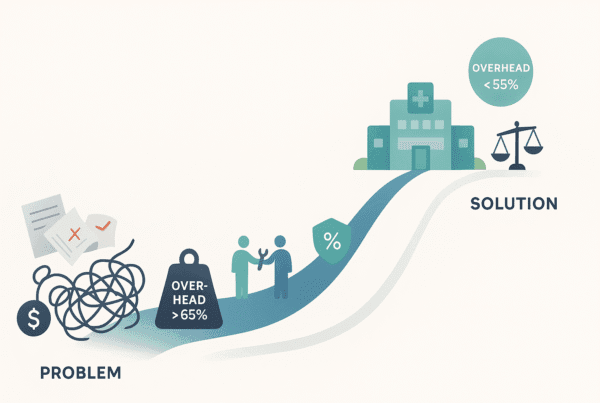
If you are thinking about selling your medical practice, you will hear one acronym more than any other: EBITDA. For most physicians, whose days are spent on patient care and clinical outcomes, financial jargon like this can seem foreign and frustrating. But understanding this single metric is one of the most financially significant things you can do.
EBITDA is the language private equity firms, MSOs, and other strategic buyers use to determine what your practice is worth. Getting it right can add hundreds of thousands, or even millions, of dollars to your final sale price. Getting it wrong is often the most expensive mistake a practice owner can make.
This guide will translate EBITDA into plain English. We will show you how it works, why it matters, and how it forms the foundation of nearly every transaction in the healthcare space. For a complete overview of how this piece fits into the bigger picture, you can read our Healthcare Practice Valuation: The Complete Guide for Medical Practice Owners.
What is EBITDA? A View from the Buyer’s Side
Think of your practice’s profitability as its engine. EBITDA—or Earnings Before Interest, Taxes, Depreciation, and Amortization—is the measure of that engine’s raw horsepower. It shows a buyer how much cash the core operation of your practice generates, before considering choices about financing, accounting, or taxes.
Here is what each component means:
* Earnings: The starting point, often the net income shown on your Profit & Loss (P&L) statement.
* Interest: The cost of your debt, such as loans for equipment or practice build-outs.
* Taxes: Federal, state, and local income taxes your practice pays.
* Depreciation & Amortization: These are non-cash accounting expenses. They represent the gradual write-down of your physical assets (like an MRI machine) and intangible assets (like the value of a patent) over time.
Buyers use EBITDA because it creates an apples-to-apples comparison. It allows them to evaluate a practice that’s ten years old and debt-free against a new, expanding practice that just took out a large loan for new equipment. By adding back these expenses, a buyer can see the fundamental, cash-producing health of both businesses on a level playing field.
The Real Metric: Understanding ‘Adjusted’ EBITDA
While standard EBITDA is a useful starting point, in healthcare M&A the valuation is almost always based on Adjusted EBITDA. This is where you, the physician-owner, can have the most impact on your valuation.
Adjusted EBITDA is the process of “normalizing” your financials. It answers the buyer’s key question: “If we owned this practice and ran it as a purely business operation, what would its annual cash flow be?” This involves adding back certain expenses that are unique to your ownership or that are not part of the recurring, core business.
The most significant adjustment for any physician-owned practice is owner compensation. As an owner, you might pay yourself a large salary, take distributions, or run personal expenses through the business. A buyer needs to adjust this to reflect what they would pay a new physician to fill your clinical role at a fair market rate. The difference is “added back” to your earnings.
| Common Adjustment (Add-Back) | Rationale from a Buyer’s Perspective |
|---|---|
| Excess Owner Compensation | Adjusts your take-home pay to a standard market-rate salary for a non-owner physician. |
| Personal or Discretionary Expenses | Removes costs like personal auto leases, family travel, or club memberships that won’t continue under new ownership. |
| One-Time Expenses | Excludes non-recurring costs like a major facility repair, a one-off legal settlement, or a large software implementation fee. |
| Related-Party Transactions | Normalizes costs like paying above-market rent to a building you own personally. |
| Family Member Salaries | Adjusts compensation for family members on payroll to what the market rate would be for their specific role. |
The normalization process is meticulous and critical. For a more detailed breakdown of these items, you can review our EBITDA Normalization Guide for Healthcare Practices.
A Real-World Example: Calculating Adjusted EBITDA
Let’s see how this works in practice. Consider a gastroenterology group with a reported net income of $800,000 for the year.
- Start with Net Income: $800,000
- Add back Interest, Taxes, Depreciation/Amortization: Let’s assume this totals $150,000.
- Initial EBITDA = $950,000
- Make Owner-Specific Adjustments:
- The owner-physician paid herself a $500,000 salary. The fair market rate for her role is $400,000. The $100,000 difference is added back.
- The practice paid for a $15,000 family vacation coded as “conference travel.” This $15,000 is added back.
- Make One-Time Expense Adjustments:
- The practice had a $50,000 one-time legal fee related to a partnership dispute. This non-recurring expense of $50,000 is added back.
The Calculation:
$950,000 (Initial EBITDA) + $100,000 (Excess Comp) + $15,000 (Personal Travel) + $50,000 (Legal Fee) = $1,115,000
In this scenario, the Adjusted EBITDA is $1,115,000—more than $300,000 higher than the reported net income. This difference has a massive impact on the final sale price.
The Multi-Million Dollar Impact: How EBITDA Drives Your Valuation
The value of your practice is calculated with a straightforward formula:
Enterprise Value = Adjusted EBITDA x Valuation Multiple
That formula reveals a powerful truth: every dollar of Adjusted EBITDA you can legitimately identify is magnified by your valuation multiple. If a practice in your specialty trades for a 7x multiple, finding an additional $100,000 in valid add-backs increases your practice’s value by $700,000.
This is why the hard work of calculating Adjusted EBITDA is so crucial. It is not just an accounting exercise; it is the most direct way to increase the financial outcome of your exit. The multiple itself depends on many factors like your specialty, size, and growth prospects, which you can explore in our guide to Valuation Multiples by Medical Specialty.
Common EBITDA Mistakes That Cost Physicians Dearly
Preparing your financials for a sale is a strategic process. Many owners make unforced errors that reduce their final valuation.
Mistake 1: Sloppy Bookkeeping
Buyers and their advisors will scrutinize your financials. If your business and personal expenses are mixed together in your QuickBooks without clear documentation, it becomes difficult to prove your add-backs. A buyer will not just take your word for it. This is why a formal Quality of Earnings (QoE) analysis is a standard part of due diligence, designed to validate your EBITDA claims.
Mistake 2: Ignoring “Small” Expenses
A $500 monthly expense for software you no longer use or a personal subscription might seem minor. But over a year, that is $6,000 in lost EBITDA. At a 7x multiple, that small oversight costs you $42,000 in enterprise value. Diligence in tracking every non-essential expense pays off.
Mistake 3: Waiting Until You Are Ready to Sell
The best time to start thinking about your EBITDA is one to two years before a sale. Trying to reconstruct years of financials retroactively when a buyer is at the table is a major red flag. It creates suspicion and can derail a deal. Consistent, clean bookkeeping demonstrates operational maturity and builds buyer confidence.
From Financial Metric to Financial Freedom
EBITDA is more than an acronym. It is the core measure of your practice’s health and the key driver of its value. By understanding how your decisions about expenses and compensation translate into Adjusted EBITDA, you move from being just a practitioner to a strategic business owner.
This process requires expertise. At SovDoc, we specialize in helping physician-owners navigate this process. We work with you to analyze your financials, identify all valid adjustments, and present your practice in a way that stands up to buyer scrutiny and maximizes its value.
Ready to understand your practice’s true Adjusted EBITDA? Contact our team for a confidential valuation consultation and discover how to position your practice for maximum value in today’s market.
Frequently Asked Questions
What is EBITDA and why is it important for valuing my medical practice?
EBITDA stands for Earnings Before Interest, Taxes, Depreciation, and Amortization. It measures the core operational profitability of your practice by focusing on cash earnings before accounting for financing, tax strategies, and non-cash expenses. Buyers prefer EBITDA because it allows them to compare practices on a level playing field regardless of debt or accounting choices, making it the most important financial metric in determining your practice’s value.
How do I calculate Adjusted EBITDA for my physician-owned practice?
To calculate Adjusted EBITDA, you start with your net income, add back interest, taxes, depreciation, and amortization to get EBITDA, then make adjustments specific to your ownership. These include adding back excess owner compensation (compared to a fair market salary for a non-owner physician), personal or discretionary expenses coded as business costs, one-time or non-recurring fees, family member salaries that exceed market rates, and related-party transactions such as above-market rent. This normalization provides a realistic cash flow figure a buyer values.
Why do buyers add back my salary to calculate Adjusted EBITDA?
Buyers add back or adjust owner compensation because, as an owner, you might pay yourself a salary above market rates, take distributions, or run personal expenses through the business. Buyers want to see what the practice would earn if it hired a physician at a fair market rate. The difference between your current pay and a fair salary is added back to EBITDA to reflect the true economic earnings of the practice.
How does increasing my Adjusted EBITDA affect the sale price of my medical practice?
Your practice’s sale price is calculated as Adjusted EBITDA multiplied by a valuation multiple (which varies by specialty and market conditions). Every additional dollar you can legitimately add back to EBITDA is magnified by this multiple. For example, if your practice’s multiple is 7x, adding $50,000 to your Adjusted EBITDA increases your enterprise value by $350,000. Thus, optimizing EBITDA directly boosts your sale price significantly.
What are common mistakes physicians make regarding EBITDA that can reduce their practice’s value?
Common mistakes include sloppy bookkeeping which mixes personal and business expenses, making add-backs hard to prove; ignoring small recurring non-operational expenses that add up and reduce EBITDA; and waiting until a buyer appears to prepare financials, which raises red flags and reduces buyer confidence. Doing proper, consistent financial preparation well before a sale is crucial for maximizing your practice’s valuation.



